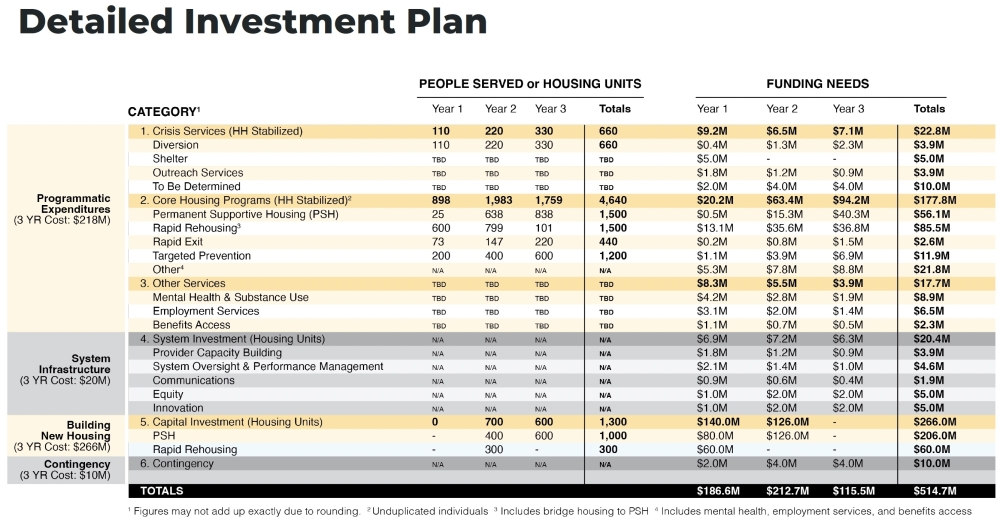The FindingHomeATX initiative, a partnership among local governments, nonprofits, businesses and philanthropists, began last year in the wake of a community summit aimed at addressing unsheltered homelessness in Austin. Since then, hundreds of millions of dollars have been lined up in support of the program designed to house at least 3,000 people, construct more than 1,000 new supportive housing units and improve the local homeless response system by the end of 2024.
During a Nov. 2 update on the program's progress so far, FindingHome leaders shared $449.14 million of the estimated $515 million total needed to reach those goals—87.21%—has been or is expected to be secured. The largest contributor so far is the city of Austin with a reported $227.59 million share of those funds, followed by Texas and Travis County.
In addition to the hundreds of millions in public dollars supporting FindingHome, more than 11% of the funds committed so far have come from 20 private sources.
“The announcement today is that we’re way ahead on raising money; we are on track to meeting the goal of building new units; we’re on track to housing people. ... We are on track to ending homelessness in the city of Austin," Mayor Steve Adler said.
As of last October, FindingHome had secured just under $400 million of its total goal. After raising nearly $50 million more since then, the program now has a funding gap of $65.86 million to be filled by private sources—less than 13% of the overall total.
Millions of dollars in contributions from several new sources, including Indeed, NI and Rastegar Property Co., were announced during the event, and leaders petitioned community members and businesses to continue to fill FindingHome's financial gap.
“Personally, I think you lose the right to complain about homelessness in this city if you’re not going to be part of the solution to ending it," Adler said.
Progress so far
Representatives ranging from social justice advocates to local business leaders said the diverse group of supporters has helped to focus the initiative on a problem they all hope to address. Following the three-year plan, stakeholders hope the newly built housing and expanded response system will help Austin reach "functional zero" homelessness, or when the experience of losing housing is short and people in such situations are quickly connected with support services to be rehoused.
Joao Paolo Connolly, a FindingHome leader and organizing director with the Austin Justice Coalition, said the strides made in the past year-plus pointed to a "special momentum" in that direction.
"We have the ability to decide something really important about what kind of a city we’re going to be," he said. "Are we going to be a city that decides that we can come together and end unsheltered homelessness? Or are we going to kick the can down the road until the problem gets so big and so expensive that all we can do is sink millions and millions of dollars into ballooning crisis management budgets?”
In addition to the past year's fundraising total, representatives said FindingHome helped house 625 additional people over the past year through programs linked to the initiative. Its housing creation goal has also grown by several hundred with around 1,400 units now in some stage of development.
Dianna Grey, Austin's homeless strategy officer, said FindingHome has so far resulted in a "crystallization" of the citywide strategy for addressing homelessness. And Matt Mollica, executive director of the Ending Community Homelessness Coalition, said the past year and a half of work has improved homeless response coordination around town and set up a clearer plan for future progress.
"We’re really seeing these resources moving, and we expect now to begin to see that rate of people being rehoused really tick up," Grey said.

Future outlook
With FindingHome well underway, Grey said Austinites can expect to see more housing completed next year ahead of a "substantially larger wave" in 2024. And from a systemwide view, Mollica said the community is already better at responding to its homeless population.
“We are absolutely on track to understand the scope of the need in our population and to be able to address having the housing resource for everyone that has a need," he said.
Mollica said ECHO data showing rising homelessness numbers in the city is also tied to FindingHome. Instead of pointing to a growing population, he said the figures have added up with more resources now available to service providers for locating and connecting with people on the streets.
After several years off, Mollica also said ECHO will lead the first formal point-in-time count of the city's homeless population in early 2023.
In addition to the developments funded through FindingHome, a new program detailed this month could also help move hundreds of people off the streets and into housing faster.
Adler said around 500 households in the city have secured housing vouchers but are now unable to find a space to rent. To respond to that issue, ECHO is leading an incentive program boosted by $500,000 in city funds that will provide thousands of dollars to Realtors who connect those families with an apartment.
Following up on the initial 2021 summit, FindingHome also anticipates hosting a second homeless response forum next summer that will provide another check-in on progress and homeless services in the city.
Beyond that, Grey said the foundation of 1,400 supportive housing units and an improved homeless response system will set up the city to respond beyond FindingHome's end in 2024.
“Really what this effort is about is that catching up; let’s sort of clear these many people who have been in a bottleneck system for so long. And then I do think that we’ll have to look at what resources we’ll need going forward, but we don’t anticipate that we would need this level of resource into the future indefinitely," she said. "This is really about addressing a situation that’s been unattended for a long time.”





